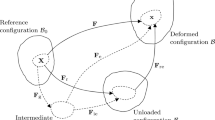Abstract
The present manuscript documents our first experiences with a computational model for stress- induced arterial wall growth and in-stent restenosis related to atherosclerosis. The underlying theoretical framework is provided by the kinematics of finite growth combined with open system thermodynamics. The computational simulation is embedded in a finite element approach in which growth is essentially captured by a single scalar-valued growth factor introduced as internal variable on the integration point level. The conceptual simplicity of the model enables its straightforward implementation into standard commercial finite element codes. Qualitative studies of stress-induced changes of the arterial wall thickness in response to balloon angioplasty or stenting are presented to illustrate the features of the suggested growth model. First attempts towards a patient-specific simulation based on realistic artery morphologies generated from computer tomography data are discussed.
Similar content being viewed by others
References
ABAQUS User’s Manual—Version 6.5. (2005) ABAQUS. Inc., USA
Balzani D, Schröder J, Gross D, Neff P (2005) Modeling of anisotropic damage in arterial walls based on polyconvex stored energy functions. In: Owen DRJ, Oñate E (eds), Proceedings of ‘COMPLAS 2005’. CIMNE, Barcelona, Spain
Blomme MD, Xu C, Law D, Masuda H, Zarins CK, Taylor CA (2006) Circumferential variation in aortic wall strain and medial lamellar architecture submitted for publication
Cipra BA (2005) Patient-specific models take aim at uncertainty in medical treatment. SIAM News, 38
Cowin SC, Hegedus DH (1976) Bone remodelling I: theory of adaptive elasticity. J Elasticity 6:313–326
Cowin SC, Humphrey JD (2001) Cariovascular Soft Tissue Mechanics. John Wiley, Chichester – New York
Epstein M, Maugin GA(2000) Thermomechanics of volumetric growth in uniform bodies. Int J Plasticity 16:951–978
Garikipati K, Arruda EM, Grosh K, Narayanan H, Calve S(2004) A continuum treatment of growth in biological tissue: The coupling of mass transport and mechanics. J Mech Phys Solids 52:1595–1625
Gasser TC, Holzapfel GA(2002) A rate–independent elastoplastic constitutive model for biological fiber–reinforced composites at finite strains: Continuum basis, algorithmic formulation and finite element implementation. Comp Mech 29:340–360
Himpel G, Kuhl E, Menzel A, Steinmann P (2005) Computational modelling of isotropic multiplicative growth. Comp Mod Eng Sci 8:119–134
Holzapfel GA(2000) Nonlinear solid mechanics: a continuum approach for engineering. John Wiley, New York
Holzapfel GA (2001) Biomechanics of soft tissues. In: Lemaitre J (ed) The handbook of materials behavior models, vol III, Multiphysics Behaviors. Academic, Boston, pp 1049–1063
Holzapfel GA (2004) Computational biomechanics of soft biological tissue. In: Stein E, de Borst R, Hughes TJR (eds) Encyclopedia of computational mechanics, vol 2. John Wiley, New York, pp 605–635
Holzapfel GA, Ogden RW(2003) Biomechanics of soft tissue in cardiovascular systems. CISM Courses and Lectures No. 441. Springer, Berlin Heidelberg New York
Holzapfel GA, Ogden RW(2006) Mechanics of biological tissue. Springer, Berlin Heidelberg New York
Holzapfel GA, Gasser TC, Ogden RW(2004) Comparision of a multi-layer structural model for arterial walls with a Fung-type model, and issues of material stability. J Biomech Eng 61:1–48, 2004
Holzapfel GA, Stadler M, Gasser TC(2005) Changes in the mechanical environment of stenotic arteries during interaction with stents: Computational assessment of parameteric stent designs. J Biomech Eng 127:166–180
Humphrey JD(2002) Cardiovasular solid mechanics. Springer, Berlin Heidelberg New York
Humphrey JD, Delange SL(2004) An introduction to biomechanics. Springer, Berlin Heidelberg New York
Humphrey JD, Rajagopal KR(2002) A constrained mixture model for growth and remodeling of soft tissues. Math Models Methods Appl Sci 12:407–430
Kuhl E, Balle F(2005) Computational modeling of hip replacement surgery: Total hip replacement vs. hip resurfacing. Technische Mechanik, 25:107–114
Kuhl E, Garikipati K, Arruda EM, Grosh K(2005) Remodeling of biological tissue: Mechanically induced reorientation of a transversely isotropic chain network. J Mech Phys Solids 53:1552–1573
Kuhl E, Menzel A, Steinmann P(2003) Computational modeling of growth: A critical review, a classification of concepts and two new consistent approaches. Comp Mech 32:71–88
Kuhl E, Steinmann P(2003) Mass– and volume specific views on thermodynamics for open systems. Proc R Soc Lond 459:2547–2568
Kuhl E, Steinmann P(2003) On spatial and material settings of thermo–hyperelastodynamics for open systems. Acta Mech 160:179–217
Lee EH(1969) Elastic-plastic deformation at finite strains. J Appl Mech 36:1–6
Libby P, Aikawa M(2002) Stabilization of atheroscleroic plaques: new mechanisms and clinnical targets. Nat Med 8:1257–1262
Lubarda VA, Hoger A(2002) On the mechanics of solids with a growing mass. Int J Solids Struct 39:4627–4664
Lubliner J(1990) Plasticity Theory. Macmillan Publishing Company, New York
Maas R(2005) Biomechanics of soft tissues. Diploma thesis, LTM, University of Kaiserslautern, U05–01
Menzel A(2005) Modeling of anisotropic growth in biological tissues—a new approach and computational aspects. Biomech Model Mechanobiol 3:147–171
Ogden RW, Saccomandi G, Sgura I(2005) A phenomenological three-dimensional theory of the wormlike chain. Proc R Soc Lond A, (in press)
Rodriguez EK, Hoger A, Mc Culloch AD(1994) Stress-dependent finite growth in soft elastic tissues. J Biomech 27:455–467
Ross R(1999) Atherosclerosis—An inflammatory disease. N Engl J Med 340:115–126
Ruggeri ZM(2002) Platelets in atherothrobosis. Nat Med 8:1227–1234
Shah PK(1997) Plaque disruption and coronary thrombosis: new insight into pathogenesis and prevention. Clin Cardiol 20 (Suppl. II):II–38–II–44
Taylor CA, Hughes TJR, Zarins CK(1998) Finite element modeling of three-dimensional pulsatile flow in the abdominal aorta: relevance to atherosclerosis. Ann Biomed Eng 26:975–987
Zhou R-H, Lee T-S, Tsou TC, Rannou F, Li Y-S, Chien S, Shyy JY-J(2003) Stent implantation activates akt in the vessel wall: role of mechanical stretch in vascular smooth muscle cells. Arterioscler Thromb Vasc Biol 23:2015–2020
Zohdi TI(2005) A simple model for shear stress mediated lumen reduction in blood vessels. Biomech Model Mechanobiol available online first: DOI 10.1007/s10237–004–0059–2, 2005
Zohdi TI, Holzapfel GA, Berger SA(2004) A phenomenological model for atherosclerotic plaque growth and rupture. J Theor Biol 227:437–443
Author information
Authors and Affiliations
Corresponding author
Rights and permissions
About this article
Cite this article
Kuhl, E., Maas, R., Himpel, G. et al. Computational modeling of arterial wall growth. Biomech Model Mechanobiol 6, 321–331 (2007). https://doi.org/10.1007/s10237-006-0062-x
Received:
Accepted:
Published:
Issue Date:
DOI: https://doi.org/10.1007/s10237-006-0062-x




